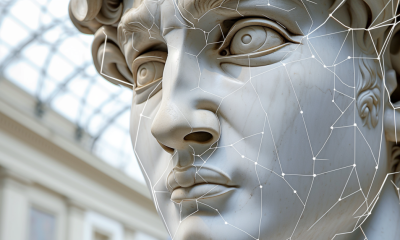Artificial Intelligence
Scientists Use Modified Facial Recognition Techniques To Discover Dark Matter

If there is one thing the general public is familiar with when the use of artificial intelligence than it is facial recognition. Whether it is opening their mobile phone or the algorithms Facebook uses to find eyes or other parts of a face in images, facial recognition has become a standard.
But now scientists dealing with complex questions like the composition of the universe are starting to use a modified version of the ‘standard’ facial recognition in an attempt to discover how much of the dark matter there is in the universe and where it is possibly located.
As Digital Trends and Futurity note in their reports on the subject, “physicists believe that understanding this mysterious substance is necessary to explain fundamental questions about the underlying structure of the universe.”
It is the researchers gathered in Alexandre Refregier’s group at the Institute of Particle Physics and Astrophysics at ETH Zurich, Switzerland that has started to use deep neural network methods that lie behind facial recognition to develop new, special tools to attempt to discover what is still a secret of the universe for us.
As Janis Fluri, one of the researchers working on the project told Digital Trends, “The algorithm we [use] is very close to what is commonly used in facial recognition,” adding that“the beauty of A.I. is that it can learn from basically any data. In facial recognition, it learns to recognize eyes, mouths, and noses, while we are looking for structures that give us hints about dark matter. This pattern recognition is essentially the core of the algorithm. Ultimately, we only adapted it to infer the underlying cosmological parameters.”
As is explained, the scientists hypothesize that dark matter accounts for around 27% of the universe, outweighing visible matter by a ratio of approximately six to one. The theory also goes that dark matter gives the galaxies “ the extra mass they require to not tear themselves apart like a suicidal paper bag. It is what drives normal matter in the form of dust and gas to collect and assemble into stars and galaxies.”
What the researchers are looking for are the areas around the clusters of galaxies that appear warped. By using reverse-engineering “they can then isolate where they believe the densest concentrations of matter, both visible and invisible, can be found.”
Fluri and Tomasz Kacprzak, another researcher in the group explained that they trained their neural network feeding it computer-generated data that actually simulates the universe. Their repeated analysis of the dark matter maps gave them the possibility to extract ‘cosmological parameters’ from the real images of the sky.
The results they achieved by comparing them to standard methods used in this process showed a 30% improvement, based on human-made statistical analysis. As Fluri explained, “the A.I. algorithm needs a lot of data to learn in the training phase. It is very important that this training data, in our case simulations, are as accurate as possible. Otherwise, it will learn features that are not present in real data.”
After training the network they fed it actual dark matter maps obtained from KiDS-450 dataset, made using the VLT Survey Telescope (VST) in Chile. This dataset covers a total area of some 2,200 times the size of the full moon and contains records of around 15 million galaxies.
As Futurity explains, by repeatedly analyzing the dark matter maps, the neural network taught itself to look for the right kind of features in them and to extract more and more of the desired information.“In the Facebook analogy, it got better at distinguishing random oval shapes from eyes or mouths.”












